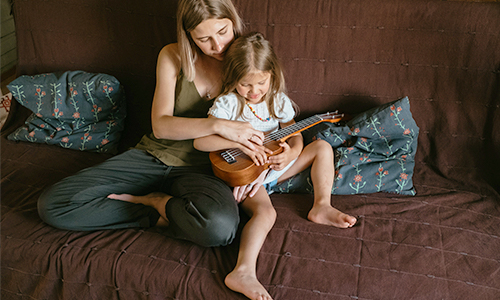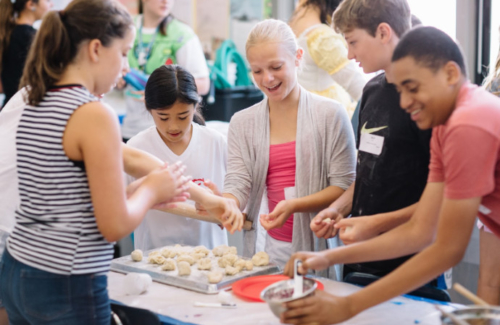Getting Kids to Try New Things: Strategies That Really Work

Trying new things can be uncomfortable, exhausting and scary—even for adults. But we encourage our kids to do it because we know that, quite simply, trying new things leads to learning. And we want our kids to be curious, independent, well-rounded individuals, primed to experience everything life has to offer, from food and friendships to playing sports and performing.
Whether you call it a growth mindset or an innovator’s mindset, the important lesson for kids to learn is that you’re not expected to be good at something the first time you try it. And in fact, becoming good at something new usually involves making lots of mistakes, getting lots of help and working really hard. But the more you do it, the more you learn, the more confident you feel and the more you can ultimately achieve. In short, it’s a lesson worth learning.
How Can We, as Parents, Teach Our Kids This Lesson?
1. Embrace “the power of yet”
Carol Dweck’s ideas about “not yet” provide a powerful way to reframe your kids’ efforts: It’s not that they can’t do it, it’s that they can’t do it yet. Embracing this shift in thinking—I’m nowhere vs. I’m on a path—can change their whole mindset. Here’s how to reinforce it:
Get in the zone.
Ideally, your kids should be trying new things that are beyond their comfort level—but not by too much. In order for them to truly learn, their new undertakings should exist in the zone of proximal development, the space just beyond what they can do on their own, but not totally out of reach.
Demonstrate the value of repetition.
Remind your kids that almost no one (even the best athletes and entertainers in the world) is great at something the first time they try it. So if you don’t immediately excel at a new thing, the good news is that you’ll be a little better at it the next time. And even better the time after that. And so on and so on.
Set incremental goals.
It’s great to have big goals, but simply setting a goal of, say, getting the lead in the school musical or skiing a black diamond might be too much to bite off all at once. Instead, help your kids set some incremental steps on the way to the big goal, like playing a part in the chorus or mastering a range of blue runs. Identifying those smaller goals and celebrating them along the way makes the ultimate goal feel more manageable (and a lot more fun to work towards).
Help them see progress.
The “not yet” approach benefits from lots of reminders about how much your kids’ efforts so far are already paying off. When your son is frustrated that he can’t play a whole song on his clarinet, for example, remind him how recently it was that he couldn’t play a single note. You might also track your kids’ endeavors on a chart or in a journal, so they can see their progress as they work towards their goals.

2. Respond positively to effort
How we respond to our kids’ forays into new things can either set them up for success or shut them down before they really get started. Here are some helpful guidelines:
Use non-evaluative feedback.
Look at your kids’ efforts and actions rather than judging the outcomes. Even just being descriptive (“Wow, look at this drawing! You filled up the whole paper.”) helps them to shift their work to an intrinsic action—something they’re doing for themselves—rather than an extrinsic one—something they’re doing just to get your approval.
Praise thoughtfully.
As tempting as it is, don’t praise your kids’ intelligence or talent. Praise the effort they put in, their determination, their progress and the strategies they used along the way. This type of praise helps shape kids who are, in Dweck’s words, “hardy and resilient.”
Don’t focus too much on what didn’t go right.
While constructive criticism certainly has its place, with a new accomplishment, it can be more supportive to simply praise the parts of the effort that were successful. For example, if your toddler gets dressed all by herself, simply celebrate that she got her shirt on, rather than pointing out that it’s on backward.
Tips for Giving Kids Thoughtful, Non‑Evaluative Praise:
|
|---|
3. Relieve the pressure
Kids walk into any situation with a lot of baggage—about what they expect of themselves, what they think other people expect of them, how they should perform—that makes stepping out their comfort zone feel like a big risk. If you can help lighten that load, they’ll find trying new things infinitely easier. Here’s how to help:
Lower the stakes.
For example, if your kid only has one canvas for her final art project and really wants to paint her first mermaid, that could feel like pretty high stakes. Ease that pressure by giving her a lower-stakes starting point. For example, present her with fun challenges: Have her draw a mermaid on scratch paper for exactly one minute, or try sketching one with her eyes closed. Many times, after kids get past their initial nerves and get something on the page, they find it easier to go back and try again or discover something they can build on.
Make it fun (and funny!).
Humor is a tried-and-true technique for relieving pressure in any situation. For example, if you want your kid to try a new food, you might model tasting it in a very goofy way (in the form of the smallest crumb ever, on the tip of your outstretched tongue, along with a funny noise, etc.) and then encourage him to do the same. Or if he’s reluctant to try a new skill, you could both do it in a silly style first, getting the newness out of the way with a low-pressure laugh before trying it again in earnest.
4. Make it a family affair
Kids aren’t the only ones who benefit from trying new things. Make embracing challenges and stretching beyond your comfort zone part of your family values. Here’s how to make the process more collaborative:
Talk about doing new things.
Take time to talk as a family about the benefits of trying new things. Remember times in your life when you’ve done it, how it made you feel and what the results were. What’s something that seemed scary at first that you love doing now? What’s something you’ve always wanted to try but still feel a little intimidated by? What are the “not yets” in your life?
Do new things as a family.
Make goals as a family to try new things and then do them! For example, as a family, set the goal of trying one new thing a week for a month. Start with low-risk things you can do together, like picking something you’ve never tried at the grocery store and including it in that night’s dinner. Once you’re regularly ticking off low-risk goals, the bigger risks (trying out for a new team, taking a new class) won’t feel quite so intimidating.
Model doing new things.
It’s incredibly powerful for kids to see their parents trying new things—especially if they’re not awesome at them from the start. If you’ve always wanted to draw, for example, get a sketchbook and draw for 5 or 10 minutes a day. Track your progress and let your kids see how much consistent effort you’re putting in. Or sign up to run a 5K, 10K or a marathon (whatever’s just outside your comfort zone). Share your training plan with your kids and let them help you track your incremental progress.
Celebrate what you do.
Trying new things never becomes truly easy, so be sure to recognize each other and expressly praise your child’s effort when she tries something new. Even when you’re still very much in the “not yet” zone, all that hard work and practice—and the lifelong habits they build—are very worth celebrating.

 Getting Kids to Talk (And Keep Talking) About Their School Day
Getting Kids to Talk (And Keep Talking) About Their School Day  Encouraging Courage in Kids: 8 Easy Tips
Encouraging Courage in Kids: 8 Easy Tips  Building the Character Traits You Want to See in Your Kids
Building the Character Traits You Want to See in Your Kids 